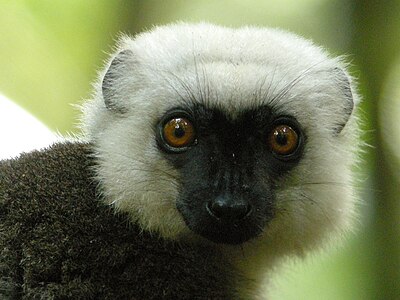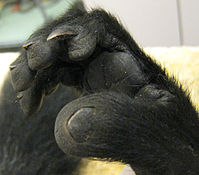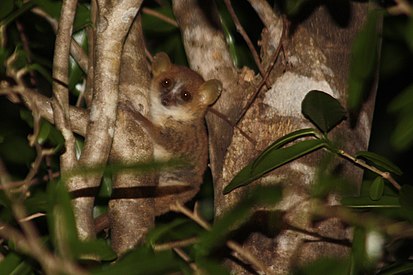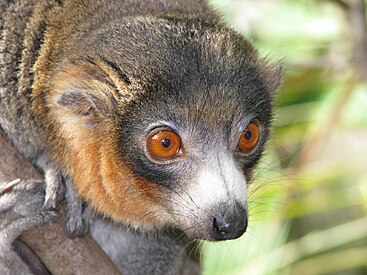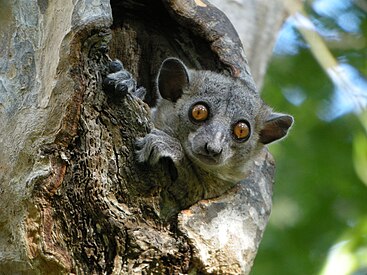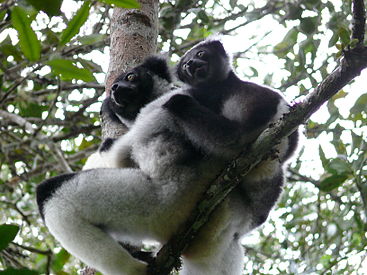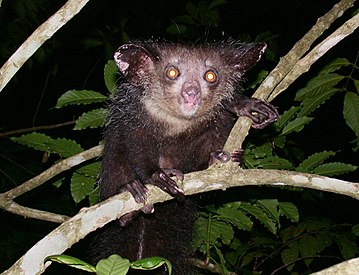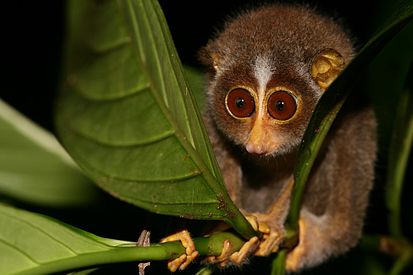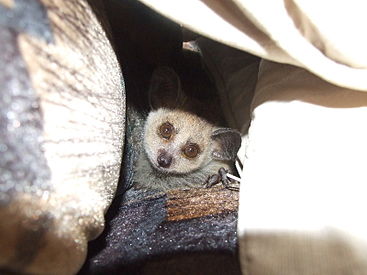Biological Anthropology/Unit 2: Non-human Primates/Overviews of Living Primates
Contents
IMPORTANT NOTE: THESE PAGES WILL NO LONGER BE UPDATED. THEY HAVE BEEN MOVED TO PRESSBOOKS AS PART OF A COLLEGE INITIATIVE TO COLLECT OER MATERIALS IN ONE PLACE FOR STUDENTS.
Overview of Living Primates
The following pages provide a very brief overview of some of the primates living today. It is not in any way a complete list of the hundreds of primate species. It is intended to give you a basic idea of the behaviors of some of the Strepsirhines and Haplorhines. If you would like to learn more about the primates mentioned on the overview pages, check out the reference section, which has links to sources with more details.
The Strepsirhines
Lemuroidea

Lemurs, which means “ghosts,” are small primitive primates ranging in size from about two ounces for the lesser mouse lemur to about 13 pounds for the Indri. They have a wet rhinarium, which indicates that the sense of smell is important. They have a dental comb and a “toilet claw” (grooming claw located on the second toe of the hind foot) both of which are used for grooming; the toilet claw is also used while eating. With the exception of the mouse lemur, lemurs are hindlimb-dominated quadrupedalists who are found equally in trees and on the ground. Many of the species, including sportive and ring-tailed lemurs, scent mark their territories.
There are two superfamilies of Strepsirhines: 1) Lemuroidea, which includes the families Cheirogaleidae, Daubentoniidae, Indriidae, Lemuridae, and Leipilemuridae, and 2) Lorisidea, which include the families Lorisidae and Galagidae.
Mouse and Dwarf Lemurs
Cheirogaleidae, or mouse and dwarf lemurs, are nocturnal, arboreal insectivores that move around by hopping on their hind legs and leaping. They live in the forests of Madagascar. There are five genera: 1) Cheirogaleus, e.g., fat-tailed dwarf lemur and furry-eared dwarf lemur, 2) Microcebus, e.g., golden-brown mouse lemur and pygmy mouse lemur, 3) Mirza, i.e., Coquerel’s giant mouse lemur and northern giant mouse lemur, 4) Allocebus, i.e., hairy-eared dwarf lemur, and 5) Phaner, e.g., pale fork-eared lemur and Amber Mountain fork-eared lemur, and twenty-one species. Cheirogaleus , Phaner , and Mirza live in monogamous family groups while Microcebus lives in multi-male, multi-female groups. Females bear two to three offspring at a time. Gestation periods vary from 60 days for the smallest species to 89 days for the larger species. Females have three nipples, which is a trait not shared by any of the other lemurs. Mouse lemurs’ tails are at least as long as their bodies. There is some variety in diet although most dwarf and mouse lemurs are omnivorous, but some species specialize, such as Phaner that eats primarily gums.
True Lemurs
Lemuridae, or true lemurs, are diurnal primates about the size of the typical domestic cat. They have long, heavily furred tails, tufts of fur at the tips of their ears, and a long snout. Their eyes are smaller in comparison to other Strepsirhines. Found on Madagascar and the Comoro Islands, true lemurs spend a lot of time of the ground, but general rest and sleep in trees. They are vertical climbers and leapers who eat leaves, fruits, and some insects. Several of the true lemur species live in large multi-male, multi-female groups where the females dominate the males. Females also tend to defend the group even though males are generally larger than females (in other words true lemurs exhibit sexual dimorphism). Other true lemurs are solitary. There are twenty-three species of true lemurs and five extant genera: 1) Lemur, i.e, ring-tailed lemur, 2) Eulemur, e.g., brown lemurs and mongoose lemurs, 3) Varecia, e.g., red ruffed lemur, 4) Hapalemur, e.g., golden bamboo lemur, and 5) Prolemur, i.e., greater bamboo lemur.
Sportive lemurs
“The sportive lemur (Lepilemur spp.) received its name because, when threatened, it turns and raises its arms as if preparing to box” (Blashfield 2004: 2548). There are several species of sportive lemurs, including the red-tailed sportive lemur, the white-footed sportive lemur, and the northern sportive lemur. They live in the dry, evergreen forests of Madagascar. Sportive lemurs are also called weasel lemurs and weigh from 1.1 to 2.2 lbs. They have short, pointed head and large round ears. They also only have 32 teeth as compared to the true lemurs that have 36 teeth. Sportive lemurs are primarily folivores, but also eat bark, flowers, and fruit. Sportive lemurs are the only lemurs to exhibit cecotrophy [SEE cuh troh fee]. This means that they eat their own waste material that contains partially plant material in order to get as much nutrition as possible. Sportive lemurs are nocturnal vertical climbers and leapers. Males usually live alone and defend their territory from others using vocalizations, chasing, and, if necessary, fighting. Males can mate with multiple females during the mating season. Females bear one young after a gestation period of about four and a half months. Infants stay with the mother for about one year.
Leaping Lemurs
Indriids or leaping lemurs include sifakas (Propithecus), Indiri (Indri), and wooly lemurs (Avahi). They live in the rainforests, deciduous forests, and evergreen forests of Madagascar. The Indri is the largest of not only the Indriids, but the Strepsirhini in general. There is some variation in the appearance of the various Indriids. Sifakas do not have fur on their face and have sparse hair on their underside. Indris have silky fur and a stumpy tail and woolly lemurs have thick, woolly fur (as indicated by their name) and ears that are barely visible in their fur. One of the characteristics that unite the Indriids is the presence of 30 teeth instead of 36 like true lemurs. With the exception of the avahis, Indriids are diurnal. All of them are vertical climbers and leapers, leaping from tree to tree and leaping when on the ground (watch this short video to see some sifakas in (loco)motion: https://youtu.be/8RiZElNNpAY). In fact, Indris can leap up to 10 ft in a single bound. They live in small groups, which may be multi-male, multi-female or solitary/all male. Males, which are dominant, are responsible for defense of territories and indirectly contribute to infant care. Females bear one offspring at a time after a gestation period of 130-150 days. Indriids are vegetarian, focusing on leaves, buds, fruits, flowers, and bark.
Aye-aye
Named after the sound it makes, the aye-aye has only 18 teeth; its incisors grow continually, and it lacks a toilet claw. It has large eyes, making them optimal for its nocturnal lifeway. Aye-ayes average about 3 ft in length. It has large, pointed ears and a pointed nose and chin. There is an extra-long middle finger with a hooked claw that is used when hunting for insects, to probe and scrape for insect larvae, and to clean its fur (watch this video from the Duke Lemur Center to see the aye-aye in action: https://youtu.be/HB_fQ1Rg_K4). While aye-ayes are classified as insectivores, they also eat parts of Ramy and palm nuts, fungi, and fruit. These solitary quadrupeds breed throughout the year. Gestation is about 170 days and females usually have one infant at a time, normally with over a year between births. Female ranges do not overlap, but male ranges may, which occasionally results in conflict between the two males.
Lorisoidea
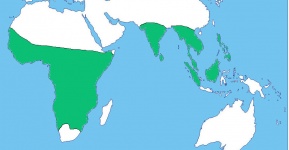
Lorises and Pottos
There are five genera (Arctocebus, Perodicticus, Pseudopotto, Loris, and Nycticebus) and about fifteen species of Lorisidae (pottos and lorises) living in sub-Saharan Africa, southeast Asia, southwest China, southern India, and Sir Lanka. These small primates weigh in from nine ounces to two pounds. To survive in areas where monkeys live, these lorisids are nocturnal so that they do not have to compete directly with monkeys. Like other nocturnal Strepsirhines, they have a reflective layer at the back of their larger eyes to help them see in the dark. Also like many of the other Strepsirhines, lorisids have a wet rhinarium, albeit short, and dental comb. All of their digits have claws, but the one on the second toe is longer, thereby qualifying as a toilet claw. They have an opposable first toe that allows them to grasp branches securely; in fact, lorisids can be found feeding while hanging upside down from tree branches! These arboreal primates prefer to forage for food on their own. While each species may have a food preference, in general lorisids are omnivores and eat insects, fruit, gum, small vertebrates, and birds’ eggs. Many lorisids exhibit a form of quadrupedal locomotion called cryptic locomotion, which means that they move slowly and deliberately. This form of locomotion helps to keep them hidden from predators; they can stay still for hours at a time. In an unusual Strepsirhine predator-avoidance adaptation, Perodicticus potto has three or four skin-covered bony spines behind its neck. This potto will tuck its head and turn the spines toward attackers in an effort to ward off a predator. After one of the longest gestation periods, 193 days, females usually give birth to two offspring who are fully matured after ten to eighteen months.
Galagos
Galagos used to be classified as a subfamily of Lorisidae, but are now classified as a separate family, Galagidae. Generally referred to as bushbabies because their cry sounds like a mewling infant, galagos are small vertical climbers and leapers who can jump up to 15 feet, using their busy tails as balance. Their arms are longer than most primates in proportion to other primates. They have soft pads on the tips of their fingers that help them cling to branches. They can move quickly, snatching flying insects in midair, which they stir up using vocalizations. Galago ears “are so important that they can fold, like an accordion, when the little animal is moving quickly through prickly or otherwise dangerous leaves” (Blashfield 2014: 2608). After a night of hunting, galagos will sleep together in a communal sleeping hole in a tree. Like pottos and lorises, galago females usually give birth to two offspring who she carries around in her mouth for about two weeks after birth. A female galago and her offspring defend a territory from foreign females. Males also defend a territory that encompasses several female territories.
Next Page: Overview of the Haplorhini
References
Allen CJ, Evans AV, McDade MC, Schlager N, Mertz LA, Harris MS, et al., editors. Lorises and Pottos: Lorisidae. In: Grzimek’s student animal life resource, Vol. 16: Mammals: Vol. 3. Detroit (MI): UXL; 2007. p.428-435
Blashfield JF. Lemurs. In: Lerner KL , Lerner BW, editors. The Gale Encyclopedia of Science, 5thedition, Vol. 5. Farmington Hills (MI): Gale; 2014. p. 2457-2550.
Blashfield JF. Lorises. In: Lerner KL , Lerner BW, editors. The Gale Encyclopedia of Science, 5thedition, Vol. 5. Farmington Hills (MI): Gale; 2014. p. 2606-2609.
Dewey T. 2008. Indriidae: indris, sifakas, and relatives. Animal Diversity Web, University of Michigan Museum of Zoology [Internet] [cited 2015 Jun 26]. Available from: http://animaldiversity.org/accounts/Indriidae/
Dewey T, Myers P. 2009. Cheirogaleidae: dwarf lemurs and mouse lemurs. Animal Diversity Web, University of Michigan Museum of Zoology [Internet] [cited 2015 Jun 26]. Available from: http://animaldiversity.org/accounts/Cheirogaleidae/
Duke Lemur Center [Internet]. Aye-aye. [cited 2015 Jun 26]. Available from: http://lemur.duke.edu/discover/meet-the-lemurs/aye-aye/
Duke Lemur Center [Internet]. Slow loris. [cited 2015 Jun 27]. Available from: Duke Lemur Center [Internet]. Aye-aye. [cited 2015 Jun 26]. Available from: http://lemur.duke.edu/discover/meet-the-lemurs/aye-aye/
Jurmain R, Kilgore L, Trevathan W. Essentials of physical anthropology, 4th edition. Belmont (CA): Wadsworth, Cengage Learning; 2013. 437 p. Larsen CS. Our origins: discovering physical anthropology. New York (NY): W.W Norton & Company, Inc.; 2008. 430 p.
Myers P. 2000. Daubentoniidae: aya-aye. Animal Diversity Web, University of Michigan Museum of Zoology [Internet] [cited 2015 Jun 26]. Available from: http://animaldiversity.org/accounts/Daubentoniidae/
Myers P. 2000. Galagidae: bushbabies and galagos. Animal Diversity Web, University of Michigan Museum of Zoology [Internet] [cited 2015 Jun 27]. Available from: http://animaldiversity.org/accounts/Galagidae/
Myers P. 2000. Lemuridae: true lemurs. Animal Diversity Web, University of Michigan Museum of Zoology [Internet] [cited 2015 Jun 26]. Available from: http://animaldiversity.org/accounts/Lemuridae/
Allen CJ, Evan AV, McDade MC, Schlager N, Mertz LA, Harris MS, editors. 2007. Sportive lemurs: Lepilemuridae. Detroit (MI): UXL. p. 466-474. (Grizmek’s Student Animal Life Resource; vol. 16).
Swartz JH. Lemurs. In: Birx HJ, editor. Encyclopedia of Anthropology, Vol. 4. Thousand Oaks (CA): SAGE Reference; 2006. p. 1459-1461.
